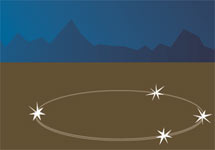

Thursday - June 3, 2010
SLAC Today is
available online at:
http://today.slac.stanford.edu
In this issue:
From the Theory Group: Anticipating the First Steps Beyond the Standard Model
SLAC Colloquium Monday: First Bio-Imaging Results from LCLS
 |
 |
|
Thursday - June 3, 2010 |
From the Theory Group: Anticipating the First Steps Beyond the Standard Model (Image: Sandbox Studios.)
The particle physics community has just entered a critical new era with the commissioning of the Large Hadron Collider. The LHC has broken through the energy frontier and the first results are beginning to come out. Ultimately, the LHC will let scientists probe the laws of physics in new ways and may potentially reveal mysterious new phenomena, indicating that our current understanding of nature is incomplete. Within the next year, the LHC could discover the first signatures of new particles, new symmetries or even extra dimensions of space-time. The data collected could solve outstanding puzzles in physics or reveal new mysteries. Physicist's knowledge of elementary particles is encapsulated in the Standard Model of particle physics, which currently describes almost everything we've seen. Yet there is compelling evidence that the Standard Model cannot be the complete description of nature. For example, despite all of its successes, the Standard Model describes only 20 percent of the mass of the Universe. Eighty percent of the mass is known as "dark matter," which we have never directly observed and know next to nothing about. Another mystery of the Standard Model is that it typically predicts that the masses of all particles are incredibly heavy. To get the observed particle masses, the parameters of the theory have to be carefully balanced—precise to one part in 1032—in order to add up many large contributions and get a small answer. The probability that this occurs randomly is like the chances of winning the California lottery four times in a row! We've seen such absurd tunings before in theories, and they almost always indicate that some physical mechanism is causing the delicate balance of parameters. The LHC is designed to discover the cause of this fine tuning of the Standard Model parameters. Of course, we don't know what mechanism solves this fine tuning problem, but numerous theories have been developed over the past 30 years. Read more... SLAC Colloquium Monday:
|
EventsAccess (see all)
Announcements
|
|
| | ||
|
|
||
 <%
Response.AddHeader "Last-modified", getArticleDate()
'Response.AddHeader "Last-modified","Mon, 01 Sep 1997 01:03:33 GMT"
'Monday, December 06, 2010
%>
<%
Response.AddHeader "Last-modified", getArticleDate()
'Response.AddHeader "Last-modified","Mon, 01 Sep 1997 01:03:33 GMT"
'Monday, December 06, 2010
%>View online at http://today.slac.stanford.edu/. |
||